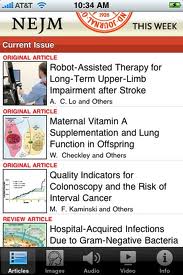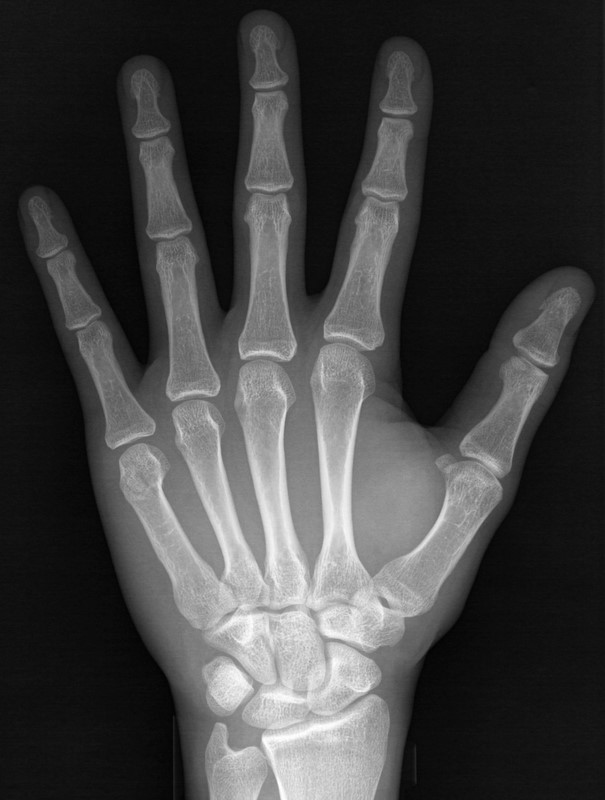Category: Critical Care
Posted: 2/8/2011 by Mike Winters, MBA, MD
(Updated: 12/5/2025)
Click here to contact Mike Winters, MBA, MD
Acute LV Dysfunction in the Critically Ill
Chockalingam A, Mehra A, Dorairajan S, et al. Acute left ventricular dysfunction in the critically ill. Chest 2010; 138:198-207
Category: Airway Management
Keywords: teaching, NEJM, app (PubMed Search)
Posted: 2/7/2011 by Rob Rogers, MD
(Updated: 12/5/2025)
Click here to contact Rob Rogers, MD
Great resource for teaching in the emergency department....
Here is a great new app that you can use when teaching residents and students in the ED. It's the NEJM app. Great pics, videos, audio, procedures, and articles. And, it's FREE.


Just go to the App store and search "NEJM"
Category: Cardiology
Keywords: hyperkalemia, digoxin, calcium (PubMed Search)
Posted: 2/6/2011 by Amal Mattu, MD
(Updated: 12/5/2025)
Click here to contact Amal Mattu, MD
For those that listen to EmedHome's EM Cast, you may have already heard this but I thought it's worth sharing with everyone else:
Many of us learned in our training that you should never give calcium to a hyperkalemic patient that is on digoxin or has digoxin toxicity. However, there's a paucity of data to support this contention. Here's one more article suggesting that calcium in the presence of digoxin or dig-toxicity may, in fact, be okay.
Levine and colleagues retrospectively evaluated 161 patients with digoxin toxicity, of whom 23 patients received calcium for hyperkalemia. None of the patients developed significant dysrhythmias in the first hour after calcium, and there was no increase in mortality rate.
Though not definitive, this is further support for treating hyperkalemia with calcium even in the presence of digoxin toxicity.
Levine M, Nikkanen H, Pallin DJ. The effects of intravenous calcium in patients with digoxin toxicity. J Emerg Med 2011;40:41-46.
Category: Pharmacology & Therapeutics
Keywords: iohexol, iodixanol, radio contrast media, immediate hypersensitivity reactions (PubMed Search)
Posted: 2/5/2011 by Bryan Hayes, PharmD
Click here to contact Bryan Hayes, PharmD
Many patients report an allergy to iodinated RCM, sometimes adding to the complexity of diagnostic decision making. Here are a few pearls to help:
Bottom line: Despite the lack of cross reactivity with shellfish/iodine allergies AND the very low risk associated with today’s low osmolality agents, premedication is still indicated in patient’s with a history of IHR to RCM.
Category: Pediatrics
Keywords: head CT, trauma, pediatrics, head injury (PubMed Search)
Posted: 2/4/2011 by Adam Friedlander, MD
Click here to contact Adam Friedlander, MD
Head injuries in children under 2yo are stress provoking, particularly with regard to when you should be getting a head CT. Luckily, a large (42,412 children, 10,718 <2yo) multi-center trial exists to guide your behavior.
Category: Toxicology
Keywords: Methemoglobinemia,methylene blue (PubMed Search)
Posted: 2/3/2011 by Ellen Lemkin, MD, PharmD
(Updated: 12/5/2025)
Click here to contact Ellen Lemkin, MD, PharmD
Category: Neurology
Keywords: stroke, seizure (PubMed Search)
Posted: 2/3/2011 by Aisha Liferidge, MD
(Updated: 12/5/2025)
Click here to contact Aisha Liferidge, MD
Category: Critical Care
Keywords: hemoglobin, anemia, transfusions, hemorrhage, conservative, liberal, hemorrhaging (PubMed Search)
Posted: 2/1/2011 by Haney Mallemat, MD
Click here to contact Haney Mallemat, MD
The optimal hemoglobin concentration during critical illness is unknown. Although a liberal transfusion strategy (Hb 10-12 g/dL) was once believed to be beneficial for hemodynamics, evidence suggests targeting a conservative strategy (Hb 7-9 g/dL) does not increase mortality, while the unnecessary transfusion of blood products can cause harm (transfusion associated lung injury, infection, etc.) in the non-hemorrhaging patient.
1. Harder, L. Et al. The Optimal Hematocrit. Critical Care Clinics (2010) vol. 26 (2) pp. 335-354
2. Hebert P, Wells G, Blajchman M, et al. A multicenter, randomized, controlled clinical trial of transfusion requirements in critical care. N Engl J Med 1999; 340(6):409–17
Category: Trauma
Keywords: Apical cap, dissection, blunt aortic injury, chest xray, radiology (PubMed Search)
Posted: 1/31/2011 by Haney Mallemat, MD
Click here to contact Haney Mallemat, MD
44 y/o female restrained driver s/p motor vehicle crash complaining of chest pain and shortness of breath.
Answer: Left pleural apical cap.
The Apical Cap
An apical cap is a unilateral or bilateral irregular density over the apex of the lung, generally less than 5mm. The lower border is often sharp but undulating.
Differential diagnosis:
Fabian TC, Richardson JD, Smith JS Jr, et al. Prospective study of blunt aortic injury: multi-center trial of the American Association for the Surgery of Trauma. J Trauma 1997;42:374-383.
McLoud TC, Isler RJ, Novelline RA, et al. The apical cap. Amer J Rad 1981; 137:299-306.
Rivas LA, Fishman JE, Munera F, et al. Multislice CT in thoracic trauma. Radiol Clin North Am2003; 41:599-616.
Category: Toxicology
Keywords: Dabigatran, anti-coagulation, toxicology, coumadin (PubMed Search)
Posted: 1/27/2011 by Fermin Barrueto
Click here to contact Fermin Barrueto
Dabigatran (Pradaxa), an antithrombin medication, was discussed in an earlier pearl and thought I would play devil's advocate and explain the possible concerns:
Toxicology Mantra: You never want to be the first person or the last person to use a drug
Category: Neurology
Posted: 1/26/2011 by Aisha Liferidge, MD
(Updated: 12/5/2025)
Click here to contact Aisha Liferidge, MD
|
Kittner SJ, Stern BJ, Feeser BR, Hebel R, Nagey DA, Buchholz DW, Earley CJ, Johnson CJ, Macko RF, Sloan MA, Wityk RJ, Wozniak MA. Pregnancy and the risk of stroke. N Engl J Med. 1996;335:768-774.
Category: Critical Care
Posted: 1/26/2011 by Mike Winters, MBA, MD
(Updated: 12/5/2025)
Click here to contact Mike Winters, MBA, MD
Valproic Acid in Status Epilepticus
Pillow MT, Malani N. Best practices for seizure management in the emergency department. ACEP News 2011; 30(1):14-16.
Category: Cardiology
Keywords: Coumadin (PubMed Search)
Posted: 1/24/2011 by Rob Rogers, MD
Click here to contact Rob Rogers, MD
Well, there may finally be a replacement for patients with atrial fibrillation who take warfarin (Coumadin).
In late 2010, the FDA approved the drug Dabigatran (Pradaxa) for use in patients with atrial fibrillation.
Dabigatran is an oral direct thrombin inhibitor that has been approved for stroke prevention in patients with A Fib. The drug does not need monitoring like warfarin, and has been deemed to be safer than warfarin.
Be on the lookout for Dabigatran...
Category: Cardiology
Keywords: bretylium, hypothermia, ventricular fibrillation (PubMed Search)
Posted: 1/23/2011 by Amal Mattu, MD
(Updated: 12/5/2025)
Click here to contact Amal Mattu, MD
Bretylium was touted for many years as the drug of choice for patients with ventricular dysrhythmias in the setting of hypothermia...in fact it still is recommended by some. Bretylium was actually touted to be effective based on animal studies in which the dogs were PRE-treated with bretylium and then hypothermia was induced. It was found that dogs that were pretreated had fewer episodes of ventricular fibrillation than dogs that were not pretreated. On the other hand, if bretylium was used as a treatment for VFib rather than a prophylactic, it was ineffective. The bottom line....don't bother with bretylium.
Category: Orthopedics
Keywords: iliotibial band, knee pain (PubMed Search)
Posted: 1/22/2011 by Brian Corwell, MD
(Updated: 2/19/2011)
Click here to contact Brian Corwell, MD
Iliotibial band syndrome (ITBS)
http://footcarexpress.com/foot-orthotics/wp-content/uploads/2009/01/iliotibial-band-syndrome.jpg
Hx -
PE-
Tx
Category: Neurology
Keywords: parkinson's disease, movemnt disorder, levodopa (PubMed Search)
Posted: 1/20/2011 by Aisha Liferidge, MD
Click here to contact Aisha Liferidge, MD
Category: Critical Care
Keywords: Apnea test, brain death, brain stem death, coma, death, cardiopulmonary death (PubMed Search)
Posted: 1/17/2011 by Haney Mallemat, MD
Click here to contact Haney Mallemat, MD
Brain death is the permanent absence of cerebral and brainstem functions (coma, absent pupillary reflexes, no spontaneous respiration, etc.). Legally, brain death is equivalent to cardiopulmonary death.
If brain death is suspected, confirmation is necessary. The apnea test is most commonly used, evaluating for spontaneous breaths when disconnected from the ventilator. If apnea testing is not possible (e.g., ambiguous clinical exam or cardiopulmonary instability) ancillary testing is needed:
Wijdicks EF, The diagnosis of brain death. N Engl J Med. 2001 Apr 19;344(16):1215-21.
Category: Visual Diagnosis
Keywords: boxer's, fracture, orthopedics, hand, brawler's, radiology, xray (PubMed Search)
Posted: 1/17/2011 by Haney Mallemat, MD
Click here to contact Haney Mallemat, MD

Boxer's (or Brawler's) Fracture
Many thanks to Dr. George Kochman for submitting this case!
Category: Cardiology
Keywords: infective endocardtiis, neurological, deficits (PubMed Search)
Posted: 1/16/2011 by Amal Mattu, MD
Click here to contact Amal Mattu, MD
Up to 30-40% of patients with infective endocarditis have neurological symptoms as a result of embolization. This is a good reminder of the frequency of embolization, and also that infective endocarditis should always be part of the differential when you are evaluating a patient with fever + neurological abnormalities.
Limkakeng AT Jr., Stahmer SA. Cardiovascular II. In Harrigan RA, Ufberg JW, Tripp ML (eds). Emergency Medicine Review: Preparing for the Boards. Elsevier, St. Louis 2010.
Category: Orthopedics
Keywords: Shoulder, Dislocation, FARES (PubMed Search)
Posted: 1/15/2011 by Michael Bond, MD
Click here to contact Michael Bond, MD
FARES Method for Reduction of Anterior Shoulder Dislocations.
This method that was recently highlighted in a publication had a ~78% success rate with the authors able to reduce the shoulder in an average of 2.36 ±1.24 minutes without having to give the patients any analgesics or sedatives. The technique is done by:
Consider trying this with your next shoulder dislocation. No single method of reduciton is 100% successful, but methods like this that only require a single provider and do not require analgesics are extremely helpful in improving patient flow as they do not utilize a lot of ED resources..
